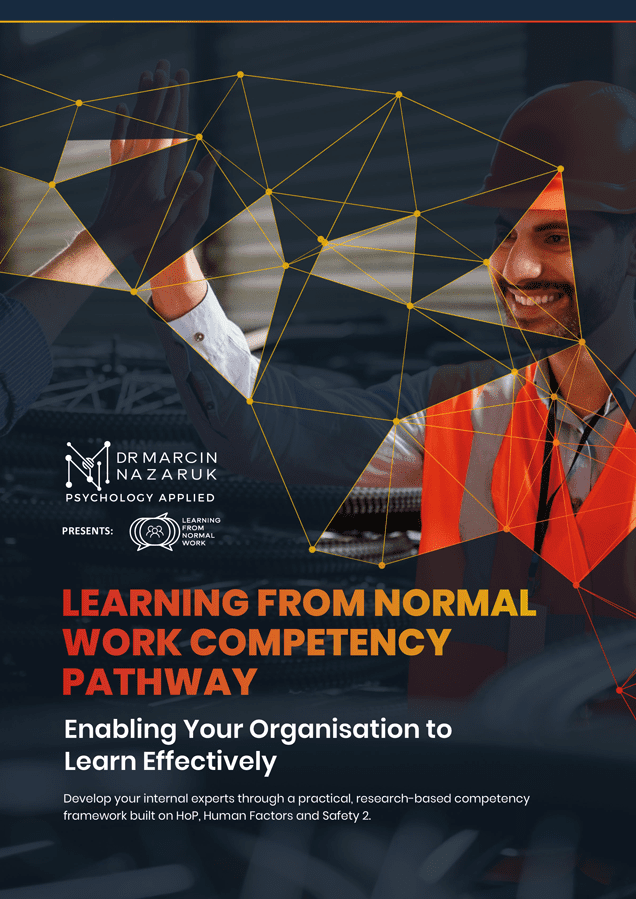I have previously worked in various sectors within the energy industry. When establishing and maintaining a safe work culture, the task typically proves daunting with a struggle to gain buy-in and find confidence in taking a hard look at strategies to identify potential pitfalls. Software applications and services frequent the safety world. Dr. Marcin Nazaruk’s latest Learning from Normal Work (LFNW) Competency Pathway teaches how to apply Human Organizational Performance (HOP) in practice to gain tangible results in improving workplace safety. It proved successful and enlightening when, as the HSE manager, I applied it to a series of work tasks managed by Gly-Tech Services, Inc.
Gly-Tech has maintained a zero incident rate for a prolonged period and, like many experiencing the same, has seized the opportunity to learn from mistakes made in the past. The challenge, however, surfaces with the notion that companies have fewer instances to learn from with fewer incidents. This proves daunting as history reveals that many of the largest industry disasters occurred in conjunction with injury-free operations. Dr. Nazaruk developed his Pathway, now accredited by the International Society for Performance Improvement (ISPI), to help companies achieve insight with this challenge.
David Buisson plays a critical role in Gly-Tech’s procurement department. His responsibilities include supervising the shipment of products and the loadouts of tools, machinery and equipment for service calls. Issues continually plague these processes and instill a negative impact in quality, safety and reputation.
Working with Buisson, we quickly assembled a learning team to seize the opportunity and utilize the Pathway. The team consisted of operational, procurement, and safety personnel to gain the perspective of multiple vantage points within the company. The Pathway’s second module directs attention at identifying constraints. Here, the learning group identified the need for more time to conduct tasks as the prevailing constraint levying that negative impact.
“Rushing and doing things at the last minute can cause someone to write down the wrong information, and when that happens, filters and other products can be shipped to the wrong address,” says Buisson.
Human error is a component discussed in the Pathway. Following the strategy of the fourth module focused on predicting potential human error, the learning team identified critical job steps, which allowed time challenges to first be pinpointed when the part or product is pulled from the shelf and prepared for shipment to the customer. The focus quickly centered on moving the product out the door to meet shipping deadlines instead of ensuring the correct product was retained for shipment.
Attempts were made to overcome time challenges by utilizing additional manpower with personnel who had not been trained on shipping and quality procedures. Additionally, employees attempted to select substitute products in order to avoid enduring additional time in locating those actually ordered. The continual repetition of this situation threatened to tarnish the company’s reputation leaving its pledge to please customers unreliable.

That negative impact on providing quality products to its customers furthered with potential issues to additionally provide a quality service. Following the strategy outlined in the sixth module, psychology of procedural non-compliance became a focus. The error trap of having multiple versions of a singular procedure surfaced which additionally illuminated the issue of procedural training not being in alignment. While out of date versions of the procedure were being followed, it grew difficult to ensure the workforce was adequately trained. These error traps compounded the time challenges being endured by the staff.
Although Gly-Tech had not endured an injury in an extended period, when surveying the potential incidents that could have surfaced, many incident precursors were identified. By following the Pathway’s tenth module focused on incident investigations, the learning team identified opportunities to learn from previous events. Job procedures, work directives, and even risk assessments were prepared in advance to guide employees in safe work behavior. It was evident the company recognized the importance of due diligence and was trying to work both safely and efficiently.
Because the company had maintained an injury-free record for so long, the surfacing of time challenges did not influence that record, so initially they did not register as critical issues. While adhering to the Pathway criteria and studying the error traps identified, the learning team discovered they could potentially avoid gaps by updating processes and improving procedures. Additionally, coaching management was identified as a method to ensure success, re-training overall taking place to ensure robust communication of expectations.
The Pathway program set up the learning team to collaborate effectively and, as the constraints were defined, the group discovered that effective communication catalyzed the process. Discussion was welcomed throughout the company, and no one felt stifled when asking questions. The group, however, realized that even though workers felt comfortable talking with management, no one expressed concern for time challenges that threatened to derail work processes.
The group harnessed the information developed, and the momentum gained and approached management. The Pathway group presented its findings to management but utilized the program to take things further. Instead of simply listing problems, the group used Pathways to counterattack against potential future incidents and injuries and developed a remediation plan.
Gly-Tech’s upper management team evaluated the learning team’s suggestions and requested immediate action. Following the Pathway modules, the group initiated the new effective and safe work campaign. Risk assessments were conducted to identify hazards for each process, and the Pathway’s error analysis tool was utilized to pinpoint which actions threatened success. Time challenges populated each assessment with robust plans to eradicate potential negative outcomes.
In order to ensure correct procedures were used to serve as work instructions, Gly-Tech shored up its document control program. After reviewing multiple versions in play, the best version was secured, improved where possible, and then documented as the correct version for release. After defining the correct procedures for use, the workforce received re-training to ensure continuity. Gly-Tech took the process further and trained the workforce on the document control procedure where employees now understood how to identify those controlled documents and avoid using incorrect versions.
It can be difficult to enact change when statistical data provides a picture of success. Gly-Tech management was guided by a zero incident rate in totality. Still, when the learning team painted a picture of reality, the realization quickly surfaced to show that the company was potentially operating on borrowed time. The company’s future success is now built upon the success gained from team engagement, which was made possible through the Learning from Normal Work Pathway program. Drilling down to the root of the operation will carry the company into the future by servicing its clients successfully while providing a safe workplace for its team of professionals.
“Identifying what could go wrong from normal work operations allows us to steer the day correctly,” says Buisson. “Thanks to the Pathway program, we have identified the importance of taking the time to identify these issues and gathering the tools and equipment needed with proper time allocation to execute our work. Pre-job and post-job meetings are critical.”
Nick Vaccaro is a freelance writer and photographer. In addition to providing technical writing services, he is an HSE consultant in the oil and gas industry with twelve years of experience. Vaccaro also contributes to SHALE Oil and Gas Business Magazine, American Oil and Gas Investor, Oil and Gas Investor, Energies Magazine and Louisiana Sportsman Magazine. He has a BA in photojournalism from Loyola University and resides in the New Orleans area. Vaccaro can be reached at 985-966-0957 or nav@vaccarogroupllc.com.






